Re: PV-2D Harpoon 84062 (Tanker 101) comes back to life
Thu Dec 22, 2011 7:07 am
G'Day Taigh,
Do you have a compass for the table and what does it look like? I don't think I have seen one before.
Love what you guys are doing to this aeroplane and look forward to seeing more of its progress.
Best regards,
Paul
Do you have a compass for the table and what does it look like? I don't think I have seen one before.
Love what you guys are doing to this aeroplane and look forward to seeing more of its progress.
Best regards,
Paul
Re: PV-2D Harpoon 84062 (Tanker 101) comes back to life
Thu Dec 22, 2011 3:42 pm
The D-12 compass is a large whiskey compass (my Swiss friends call it a Schnapps compass!) which is commonly found on Army and Navy aircraft in WWII that carried a Navigator. It is very similar to the large one used in most British aircraft even the fighters but the D-12 is just a bit bigger.
Here is a shot, shamelessly stolen from the internet, of a D-12 compass. There are several different styles but they all mount the same.

Yes I do have one in storage for the Harpoon that I haven't pulled yet. Just like most navigation gear it isn't a very expensive item to find and it is also not scarce. The D-12 compass sells for $20 to $100 depending on bidders and condition. Also like Navigation gear there are always ones up for auction at crazy prices and there they will stay until they bring the price down closer to reasonable market value.
Here is a shot, shamelessly stolen from the internet, of a D-12 compass. There are several different styles but they all mount the same.

Yes I do have one in storage for the Harpoon that I haven't pulled yet. Just like most navigation gear it isn't a very expensive item to find and it is also not scarce. The D-12 compass sells for $20 to $100 depending on bidders and condition. Also like Navigation gear there are always ones up for auction at crazy prices and there they will stay until they bring the price down closer to reasonable market value.
Re: PV-2D Harpoon 84062 (Tanker 101) comes back to life
Fri Dec 23, 2011 10:26 am
I want to say thank you to: Shane, Dan, Jerry, Dean and Pat for your kind donations via PayPal. You have donated $315 all together. Youse guys are awesome!
We also received the $10,000 check from the family foundation of a wonderful WIX member for the gun project. We are well over half way to having a full set of guns! This project would not have happened for a real long time without you all.
We are well over half way to having a full set of guns! This project would not have happened for a real long time without you all.
Thanks again for all of your support!

The gun project
We also received the $10,000 check from the family foundation of a wonderful WIX member for the gun project.
Thanks again for all of your support!

The gun project
Re: PV-2D Harpoon 84062 (Tanker 101) comes back to life
Mon Dec 26, 2011 2:39 am
k5dh wrote:Great stuff, Taigh! I love how you and your team are doing things in such an authentic manner. Very commendable! Cute kitty, too.
Glad to see you have the PayPal account set up. I'll be using it soonly.EDIT: You're now $100 closer to finishing!
Coupla silly questions:
1. What kind of lubricant are you using for your dynamotor bearings? I have several dynamotors that need to be overhauled properly and I'm open to suggestions for some kind of modern lubricant that's readily available and doesn't cost a fortune.
2. Just out of curiosity, who made your flameproof key? It's a Bendix design, but they were made by various companies including James Bunnell (CJB26003A), Moulded Insulator Company (CMI26003A), Telephonics (CTE26003A), and others. I have a whole box of those keys, but they're in really rough shape. The JB and MI keys are common as dirt. They must've made a gazillion of 'em. They were still in use on P-3's at least as late as the 1990s.
Rock on, guys 'n gals! (and cat!)
Thanks again for the donation!
Sorry I forgot to reply to your questions.
We use Aeroshell grease 22 for the bearings in dynamotors. 22 is a great high speed aircraft bearing grease that works great through a wide range of temperatures and has other desirable properties. If you want some send me your address and I will mail a vial to you.
Cool information on the explosion proof key. The key I found is Telephonics (CTE). Here are a couple of photos.
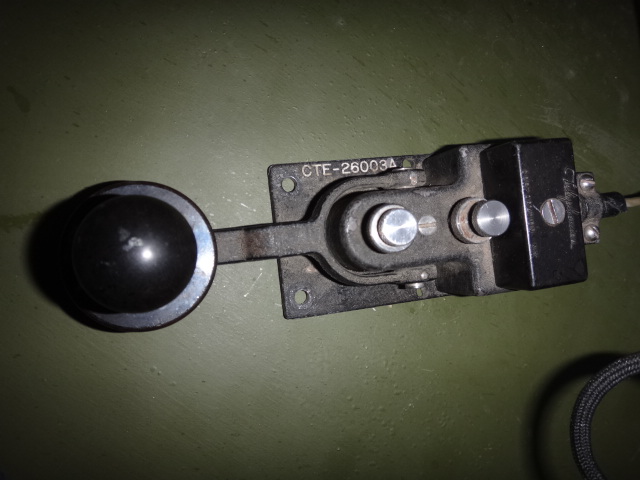
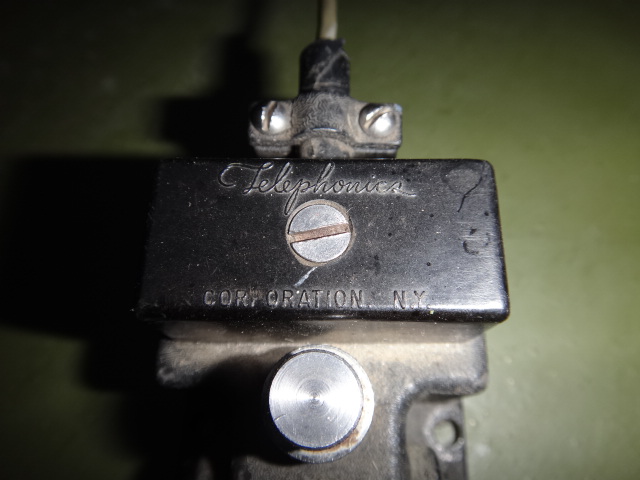
I had no idea they were still in use that late. Cool. I have to remove the radio table to install the lamp I found so I will mount the key soon. It looks like it is supposed to have a mic jack on a cord that plugged in to the jack box. Do your keys typically have mic plugs on cords?
Since we are on the subject of radios I thought I would take some time to describe the different radio systems for those who may be interested. Fair warning: radio geek speak coming up which puts most to sleep...
It seemed like the Army and the Navy sure didn't like to get together on, well, anything back in the day. Radios were certainly no exception. I think the Army and Navy were forced to get together on their needs and procurement as they were developing and buying independent radio equipment that was doing basically the same thing the other service was doing. The joint Army Navy (JAN) designation system was developed to solve these problems during WWII and is still in use today.
There are a few different types of radios on the Harpoon that use the JAN system. Most of these systems are also found on many aircraft in one form or another. The most common set is the ARC-5.
In the JAN system ARC breaks down to Airborne Radio Communication. Even though the ARC-5 is using the Joint Army Navy (JAN) nomenclature system it was typically only used by the Navy. The Army had a similar set designated SCR-274N. This is the Army's system and SCR stood for Set, Complete Radio. It is arguable one of the most well known systems because of its post was use and it was often modified by Ham's for amateur radio use. The transmitters and receivers were small and portable and easy to 'upgrade'. ARC-5 is often the name given to the three different similar sets used before and during the war namely ATA/ARA (early Navy system) SCR-274N (Army staple through the war) and the ARC-5 (late Navy). Even though folks refer to all these as ARC-5's they are really three different systems.
The ARC-5 system typically used three different receivers and two transmitters but this number varied widely. Each receiver and transmitter were built for a specific frequency range and they could be easily removed from the mounting rack and replaced with a different radio/band if necessary. The Harpoon had two receivers and three transmitters in operational racks and had storage racks for an additional two receivers and four transmitters. This set was used for short range communication like plane to ground or plane to plane. It was also used for navigation as it could tune in beacons and other early nav equipment. The pilots had control of the ARC-5 through remote tuning heads with flexible shafts and power and volume controls.
Here is a shot of the transmitters and receivers of the ARC-5 in our harpoon:
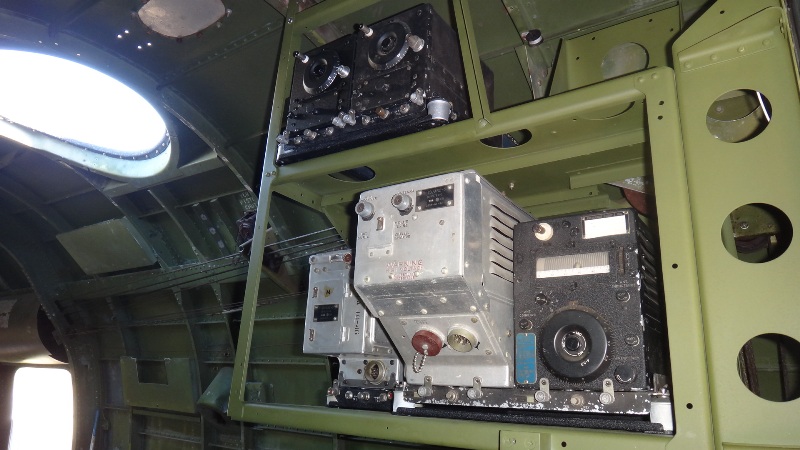
There are two of the three receivers on the top shelf and the third receiver and two transmitters on the lower shelf. This set also has the VHF transmitter and receiver (silver radios) installed which was used later in WWII. The ARC-5 used its own long wire antenna on the Harpoon from the mast above the radio room to the top of the left vertical stabilizer.
Long range communication was through the Liaison radios namely the ART-13 transmitter (Airporne Radio Transmitter) and the ARB receivers (ARB was from the early Navy designation system). The ART-13 was a technological wonder at the time. Designed by Collins is was compact when compared to the other transmitters of the day and could be remotely used. It had an autotune system that, through a motor drive, would automatically change the frequency by moving all 5 tuning dials to their pre assigned settings. This set was so successful that it was used into the early 1970's.
Here is a shot of our ART-13 (the largest radio) in the right hand mid body rack

The dynamotor below it is used to generate the high voltage power required for the transmitter.
The unit in the upper left in the photo above is the modulator for the ARC-5 system.
The ART-13 used either the long wire antenna from the mast to the right vertical stabilizer or the trailing wire antenna that ran out of the belly on the right side just aft of the radar operator.
The unit on the bottom shelf is the APN-1 (Airborne Radar Navigation) or radar altimeter. This unit would bounce radio waves off of the ground or water for accurate altitude above ground. A great set especially for Navy aircraft trying to let down through the clouds trying not to smack the water. There was a control and an indicator on the pilots instrument panel. The APN-1 used two T shaped antennas mounted on the bottom of the horizontal stabilizer.
On top is a frequency meter used to accurately set the transmitter and receiver. It actually mounts in the forward radio rack and an ARN-8 marker beacon receiver goes in its place.
The ARN-8 (Airborne Radio Navigation) receives 75MC fan beacons used for instrument let down procedures. It is the same system in use today for ILS or instrument landing systems and the fan beacons are called marker beacons. The ARN-8 used a wire antenna mounted to the right bomb bay door.
The control box for the ART-13 and the two ARB receivers are located on the radio operators bulkhead.
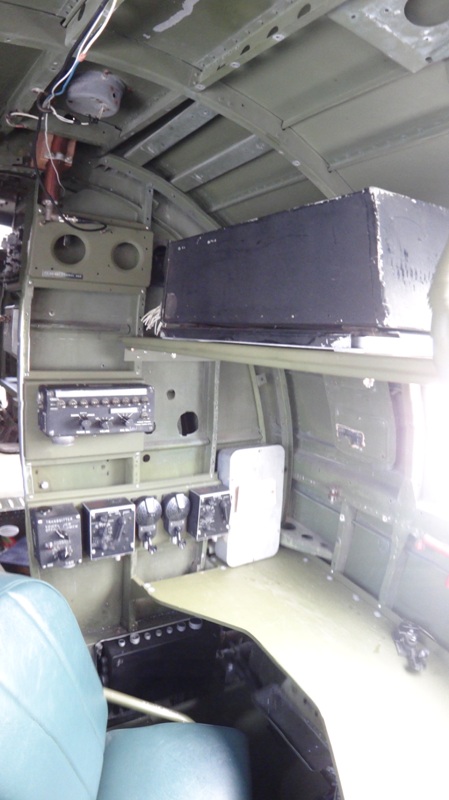
On the bottom row of the control heads from the left is the control for the ART-13 then two sets of ARB receiver controls (4 total) with the two coffee grinders in the middle. Coffee grinders refer to the crank to tune controls that resemble coffee grinders.
Above the radio operators table on the right upper side of the photo is the Automatic Direction Finder or ADF receiver. It is actually an Army BC-433 (Basic Component number 433 in the Army designation system) which was a part of the SCR-269G (Set, Complete Radio in the Army system). It is very unusual to see an Army set installed in a Navy aircraft. I still haven't seen the official documentation as to why this was done but my guess is that this was a superior system to the Bendix ADF installed in earlier Navy aircraft including Harpoons. The Army had been using the SCR-269 for a while and the Navy procured the system under the designation ARN-7. The ARN-7 became standard equipment that was used well after WWII and it was essentially the same exact set as the 269. I think that until ARN-7 sets were available the navy installed the Army sets. This is true for other aircraft as well like the PB4Y-2. Anyone have any documentation about this to share?
The ARN-7 used two antennas namely a loop antenna or football shaped antenna mounted on the top of the Harpoon and many other bomber aircraft. The loop was a directional antenna that could be rotated to home in on a signal. The other antenna was a simple wire that was called the sense antenna. The two signals were used to compare and determine the direction to the signal. On the Harpoon the sense antenna was the straight wire from the forward mast to the aft mast.
The other gear is the radar and IFF. The APS-3 (Airborne Radar Search) was a search and targeting radar that could be used for IFF work as well. IFF stands for Identification Friend or Foe. It is the early version of what we call transponders today. The IFF set or APX-2 (Airborne Radar Identification) would send out interrogation and receive responses from other gear. Used with the APS-3 radar the operator could see on his scope if a target was friendly or a foe. The code for the reply was changed daily so if you used an old code you were treated as a foe. Ships, submarines and of course other aircraft had the IFF gear. The IFF was also quite secret as you didn't want the code of the day falling into enemy hands. The transmitter/receiver had explosives installed to destroy the insides of the set during a crash through an impact switch or could be manually set off with a destruct switch. IFF gear is hard to find and we are lucky to have a full set to install in the Harpoon.
That's all for now, time for bed.
Re: PV-2D Harpoon 84062 (Tanker 101) comes back to life
Mon Dec 26, 2011 10:32 am
Taigh,
What frequency range did the ARC-5 system use and how broad was the frequency range available for each receiver or transmitter? Not knowing how these things were set up, was there a crystal installed in each unit that established the frequency range available?
How was the VHF function integrated into the unit? I would have thought that would have been a different transmitter/receiver combination altogether.
For navigation, was there a receiver for the airway ranges or any other type of navigation radios other than the ADF and fan marker receiver?
You have to wonder what the guys who designed and used these radios would think of something like a Garmin 430W with nav and comm and GPS capability all fit into one small box.
What frequency range did the ARC-5 system use and how broad was the frequency range available for each receiver or transmitter? Not knowing how these things were set up, was there a crystal installed in each unit that established the frequency range available?
How was the VHF function integrated into the unit? I would have thought that would have been a different transmitter/receiver combination altogether.
For navigation, was there a receiver for the airway ranges or any other type of navigation radios other than the ADF and fan marker receiver?
You have to wonder what the guys who designed and used these radios would think of something like a Garmin 430W with nav and comm and GPS capability all fit into one small box.
Re: PV-2D Harpoon 84062 (Tanker 101) comes back to life
Mon Dec 26, 2011 11:17 am
TAIGH:
Thanks for the pics of your key. I love the "Telephonics" logo on the terminal cover! Most of the 26003A keys that I've seen (ones that appear to be unaltered) have had a heavy duty, rubber-jacketed, two-conductor cord, 3' to 5' long, with a PL-55 style plug on the end. The cords are about 1/4" thick o.d. I've seen a couple with WW2-looking ring lugs on the ends of the conductors, but I don't believe they would have had an aircraft use. These keys were used in aircraft and aboard ships, and probably for other purposes as well. Strangely, all of the Bendix keys I've ever seen were marked "Bendix Radio Corp. Type MT11B" on the terminal cover, and don't have the "Cxx-26003A" stamping on the base.
EDIT: I found a good photo on the internet showing a Bendix key with cord and plug:
http://morsetelegraphkey.com/bendix-rad ... e-code-key
Thanks for the info on the dynamotor bearing lubricant. I'll PM you to discuss further.
And "radio geek Dean" says. . . Great dissertation on the radio gear!
SCOTT (Aerovin):
Everything you could possibly want to know about Command radios can be found on the following Wiki page:
http://en.wikipedia.org/wiki/ARC-5
Thanks for the pics of your key. I love the "Telephonics" logo on the terminal cover! Most of the 26003A keys that I've seen (ones that appear to be unaltered) have had a heavy duty, rubber-jacketed, two-conductor cord, 3' to 5' long, with a PL-55 style plug on the end. The cords are about 1/4" thick o.d. I've seen a couple with WW2-looking ring lugs on the ends of the conductors, but I don't believe they would have had an aircraft use. These keys were used in aircraft and aboard ships, and probably for other purposes as well. Strangely, all of the Bendix keys I've ever seen were marked "Bendix Radio Corp. Type MT11B" on the terminal cover, and don't have the "Cxx-26003A" stamping on the base.
EDIT: I found a good photo on the internet showing a Bendix key with cord and plug:
http://morsetelegraphkey.com/bendix-rad ... e-code-key
Thanks for the info on the dynamotor bearing lubricant. I'll PM you to discuss further.
And "radio geek Dean" says. . . Great dissertation on the radio gear!
SCOTT (Aerovin):
Everything you could possibly want to know about Command radios can be found on the following Wiki page:
http://en.wikipedia.org/wiki/ARC-5
Re: PV-2D Harpoon 84062 (Tanker 101) comes back to life
Tue Dec 27, 2011 5:09 pm
aerovin wrote:Taigh,
What frequency range did the ARC-5 system use and how broad was the frequency range available for each receiver or transmitter? Not knowing how these things were set up, was there a crystal installed in each unit that established the frequency range available?
How was the VHF function integrated into the unit? I would have thought that would have been a different transmitter/receiver combination altogether.
For navigation, was there a receiver for the airway ranges or any other type of navigation radios other than the ADF and fan marker receiver?
You have to wonder what the guys who designed and used these radios would think of something like a Garmin 430W with nav and comm and GPS capability all fit into one small box.
Hello Scott,
The ARC-5 radios covered a wide range of frequencies from .19 to 9.1MC. Each transmitter and receiver had a band like .19 to .55 or 6.0 to 9.1MC. As Dean/K5dh mentioned there is a great description on wikipedia and a chart with all of the frequencies for each radio.
Check out Mike Hanz' collection. He has the best collection imaginable of not only ARC-5 gear but of most other airborne WWII equipment. Here is the ARC-5 gear at Mike's place:
http://aafradio.org/flightdeck/arc5-1.htm
They usually had one set for navigation and others for communication. I know you are somewhat of a B-17 nut which used the SCR-274N set. I have not found any supporting documentation or information that indicates that Army aircraft carried extra command sets to change frequencies. My impression is that in the AAF the radios were set up for the mission and really weren't swapped out like may have happened in the Navy. It looks like most all WWII aircraft came with spares stored from the factory but I think the spares were removed at their destination or were liberated en route. The Harpoon is one of the only aircraft I have seen that had airframe manufacturer built storage racks for the ARC-5 transmitters and receivers (two extra receivers and four transmitters).
The VHF gear was very different than the rest of the transmitters and receivers. They slid into the same racks but had some extra connectors and control heads. The control heads had special switching to select one of the crystal controlled frequencies. I believe there were crystals in the other receivers that were used as a harmonic but that is getting way over my pay grade when it comes to electronics. I can wiggle a tube and clean relay contacts with the best of them but above that I need to call in the experts!
Here is a shot of three ARC-5 LF/MF receivers next to a beater VHF set. You can see that there is a big difference.
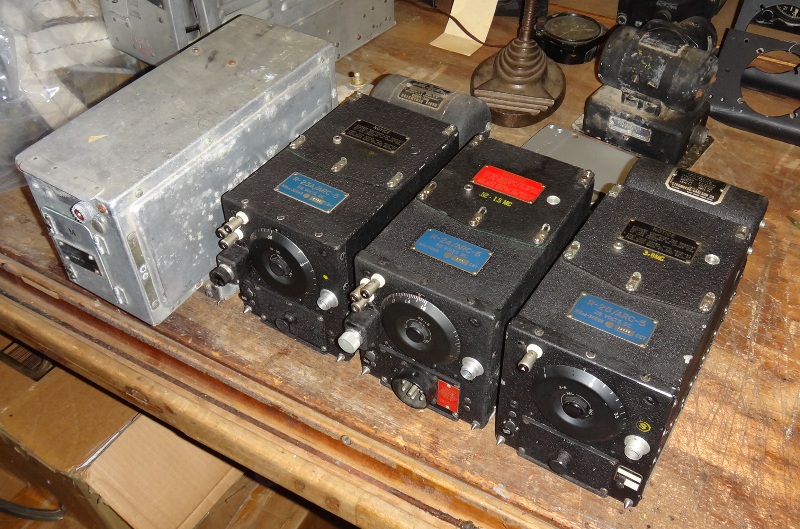
Trying to make the set fit in the rack and spill out in an acceptable direction was a chore.
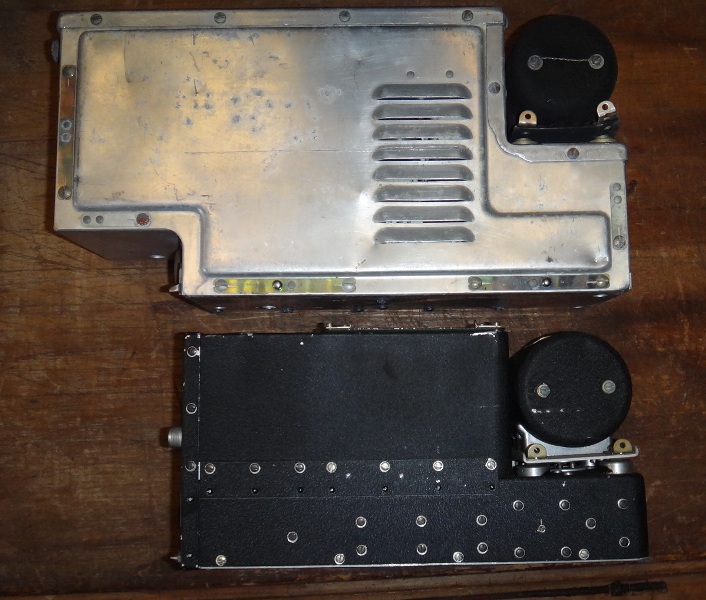
The Army adopted the SCR-522 set which was a lot larger and from what I have read was a pain to keep tuned especially when compared to the ARC-5 VHF. During the war VHF was becoming standard equipment in both the Pacific and the European theatre.
Here is a beater VHF transmitter for comparison to a nice one
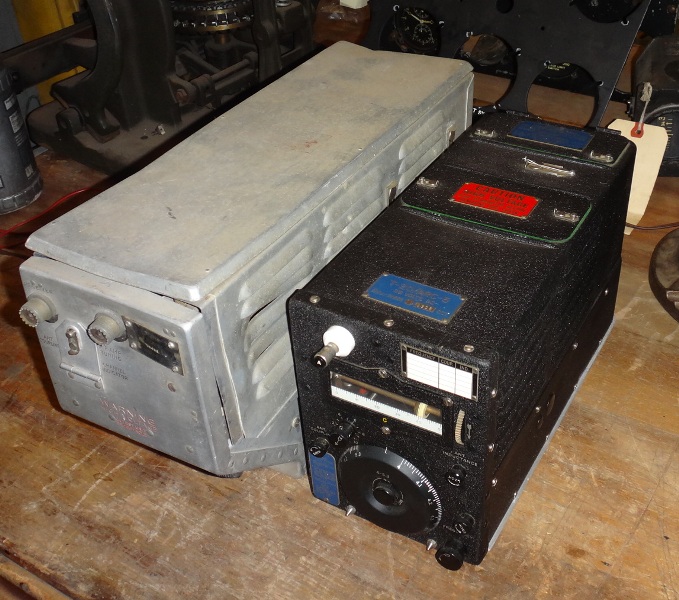
Two of the ARC-5 receivers are now stowed in the Lockheed built (as opposed to the Aircraft Radio Corporation or radio supplier) storage racks in our Harpoon. Cool more boxes back where they belong. More and more stuff to bash your head on or have to wiggle around in the Harpoon to make her more complete. Most WWII aircraft were crammed full of gear.
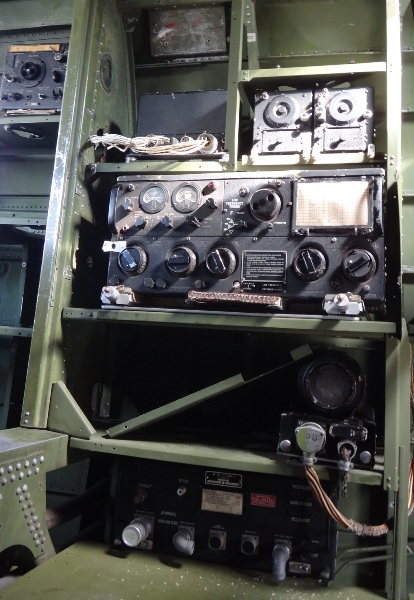
Last edited by Taigh Ramey on Tue Dec 27, 2011 8:34 pm, edited 1 time in total.
Re: PV-2D Harpoon 84062 (Tanker 101) comes back to life
Tue Dec 27, 2011 7:35 pm
I was an electronics tech in the Navy in the early 1970's my first ship was the USS Lexington (my uncle served on her in WWII). I'm enjoying all the pictures of the radios. I just missed some of these in the service, almost everything I saw was UHF. If you look at wartime Spitfire pictures you will see the antennas "shrink" through the war as they went from HF long wire, to VHF mast antennas, to small UHF whips. As the frequency went up, the wavelength decreased, and so a shorter antenna was needed.
We did have WWII RBO HF radios on the Lex used as entertainment radios. Years later when I was on another ship we recovered an RBO from a mothballed ship and used it as our ship's entertainment radio.
We did have WWII RBO HF radios on the Lex used as entertainment radios. Years later when I was on another ship we recovered an RBO from a mothballed ship and used it as our ship's entertainment radio.
Re: PV-2D Harpoon 84062 (Tanker 101) comes back to life
Tue Dec 27, 2011 7:52 pm
Not to hijack the thread, but let me just toss in this tidbit regarding the SCR-274N installation on the B-17G. The B-17G maintenance manual shows two transmitters in the operational rack on the bulkhead and a storage location on the floor in the radio room for two more. A typical installation, from what I've been told by former B-17 radio ops, was to have the BC-457 (4.0 to 5.3 mc) and BC-458 (5.3 to 7.0 mc) installed. The extras, then, would have been the BC-696 (3.0 - 4.0 mc) and BC-459 (7.0 - 9.1 mc) units. Not sure if the crews actually carried the extra transmitters or not, but I kinda doubt it since every crew was weight-conscious and the command frequencies would have been pre-briefed before the mission.
73,
Dean K5DH
73,
Dean K5DH
Re: PV-2D Harpoon 84062 (Tanker 101) comes back to life
Tue Dec 27, 2011 7:54 pm
Don't know if you are still looking, but I saw via google that this might serve your project-
http://www.ebay.com/itm/320819470384?ssPageName=STRK:MESELX:IT&_trksid=p3984.m1555.l2649#ht_500wt_898
http://www.ebay.com/itm/320819470384?ssPageName=STRK:MESELX:IT&_trksid=p3984.m1555.l2649#ht_500wt_898
Re: PV-2D Harpoon 84062 (Tanker 101) comes back to life
Tue Dec 27, 2011 8:23 pm
Yes, that is one of the parts we need to complete the APS-3 set. Thanks for the heads up.
Re: PV-2D Harpoon 84062 (Tanker 101) comes back to life
Tue Dec 27, 2011 8:59 pm
What is the black box w/meter on the back of the co-pilots balkhead, just above the hydraulic system in the original photo?
Re: PV-2D Harpoon 84062 (Tanker 101) comes back to life
Wed Dec 28, 2011 1:13 am
That would be a carbon monoxide detector.
Re: PV-2D Harpoon 84062 (Tanker 101) comes back to life
Wed Dec 28, 2011 1:36 pm
First I would like to thank our most recent donations from WIX members Scott and Rod. Because of you generosity we are closer to funding the 7th of 10 guns needed. Here is the new total:

Gun project
Thanks guys for helping to gun up the Harpoon!
Yesterday was a great day for the Harpoon on the parts acquisition front. I mentioned that we needed a good Aircraft Protractor (drafting machine) for the navigators table and one showed up on eBay. The auction fired off yesterday and we were the only bidders at $25! It is new and in the wood box too. Unfortunately it is an Army Air Force contract and not Navy but it will do until I can find the correct Navy one. They are identical except for the AAF contract information on the box and stamped on the arm. You have to look real close to find it. It'll look great on the Nav table for sure!
The other windfall yesterday was due to Kevin who signed up on WIX to tell us about an APS-3 Azimuth Calibrator that he was selling on eBay. After he posted the auction he did a google search and found our thread on the Harpoon and its radar. The Azimuth Calibrator is a very important part for the APS-3 and it one of the components that we still need to complete the set. I asked him if he would let us have it and he agreed to do so. We bought it for $10 and it in in new old stock condition and is beautiful indeed. Thank you Kevin for your kindness and help to complete the APS-3 radar project. Mostly we are in need of some correct shock mounts and connectors. The Azimuth Calibrator will mount at the radar operators station just above the table and to the right of the power unit. Too cool! Check out how beautiful the calibrator is:

Yesterday was a good day for the Harpoon. Well pretty much every day is a good day for the Harpoon as she keeps getting better and better but some days there is more progress than others.
Thanks again to all of you who have given us moral, financial, sweat equity and parts support. The Harpoon is grateful as we all are.

Gun project
Thanks guys for helping to gun up the Harpoon!
Yesterday was a great day for the Harpoon on the parts acquisition front. I mentioned that we needed a good Aircraft Protractor (drafting machine) for the navigators table and one showed up on eBay. The auction fired off yesterday and we were the only bidders at $25! It is new and in the wood box too. Unfortunately it is an Army Air Force contract and not Navy but it will do until I can find the correct Navy one. They are identical except for the AAF contract information on the box and stamped on the arm. You have to look real close to find it. It'll look great on the Nav table for sure!
The other windfall yesterday was due to Kevin who signed up on WIX to tell us about an APS-3 Azimuth Calibrator that he was selling on eBay. After he posted the auction he did a google search and found our thread on the Harpoon and its radar. The Azimuth Calibrator is a very important part for the APS-3 and it one of the components that we still need to complete the set. I asked him if he would let us have it and he agreed to do so. We bought it for $10 and it in in new old stock condition and is beautiful indeed. Thank you Kevin for your kindness and help to complete the APS-3 radar project. Mostly we are in need of some correct shock mounts and connectors. The Azimuth Calibrator will mount at the radar operators station just above the table and to the right of the power unit. Too cool! Check out how beautiful the calibrator is:
Yesterday was a good day for the Harpoon. Well pretty much every day is a good day for the Harpoon as she keeps getting better and better but some days there is more progress than others.
Thanks again to all of you who have given us moral, financial, sweat equity and parts support. The Harpoon is grateful as we all are.
Re: PV-2D Harpoon 84062 (Tanker 101) comes back to life
Wed Dec 28, 2011 3:55 pm
OUTSTANDING!!! I know we all here can't wait to see the old girl in all her finery!! 
Scott

Scott